The Enrichment of Uranium in Marine Organic-Rich Overmature Shales: Association with Algal Fragments and Implications for High-Productivity Interval
Abstract
1. Introduction
2. Geological Settings
3. Samples and Methods
3.1. Samples
3.2. Experiments
4. Results
4.1. Organic Matter (OM) Types
4.2. Uranium Content
4.3. Distribution of Uranium
5. Discussion
5.1. Uranium Enrichment Mechanisms
5.2. Enhancement of Thermal Maturation
5.3. Geological Significance
5.3.1. Implications for Shale Gas Exploration
5.3.2. Stratigraphic Division
6. Conclusions
- (1)
- One to three discrete uranium enrichment events are identified within the Wufeng–Longmaxi sequence. These high-uranium intervals correlate well with shale gas sweet spots, highlighting the value of uranium enrichment as a key indicator for sweet spot prediction.
- (2)
- The strong correlation between spectral uranium logs and gamma-ray (GR) curves confirms that uranium enrichment is the primary cause of high-GR anomalies. Uranium distribution is jointly controlled by reducing depositional conditions, volcanic activity (e.g., tuff layers), and organic matter type.
- (3)
- Uranium content (U content) shows a clear dependence on organic matter type, with algal fragments exhibiting a good positive correlation (R2 = 0.74), indicating their role as the main uranium host. Given the low uranium content in modern marine algae, uranium incorporation likely occurred during early diagenesis under favorable redox and porewater pH conditions.
- (4)
- All studied samples are overmature, with equivalent vitrinite reflectance (ERo) generally increasing with burial depth. However, ERo values in uranium-rich shales are 0.11%–0.17% higher than in non-uranium-rich shales, suggesting that uranium enrichment may have a slight enhancing effect on thermal maturity.
- (5)
- Uranium enrichment provides a practical chemostratigraphic marker for regional correlation and dating of marine shales, offering a simpler alternative to complex tuff-bed dating methods.
Author Contributions
Funding
Data Availability Statement
Acknowledgments
Conflicts of Interest
References
- Cuney, M. Evolution of uranium fractionation processes through time: Driving the secular variation of uranium deposit types. Econ. Geol. 2010, 105, 553–569. [Google Scholar] [CrossRef]
- Wang, W.J.; Chen, J.W.; Feng, X.L.; Ge, X.Y.; Zhang, Y.G.; Liang, J.; Xu, L. Sedimentary environment and organic matter enrichment mechanism of the Silurian Gaojiabian black shales in the Lower Yangtze Region, South China. Minerals 2025, 15, 204. [Google Scholar] [CrossRef]
- Wang, G.P.; Jin, Z.J.; Liu, G.X.; Liu, Q.Y.; Liu, Z.B.; Wang, H.L.; Liang, X.P.; Jiang, T.; Wang, R.Y. Geological implications of gamma ray (GR) anomalies in marine shales: A case study of the Ordovician-Silurian Wufeng-Longmaxi succession in the Sichuan Basin and its periphery, Southwest China. J. Asian Earth Sci. 2020, 199, 104359. [Google Scholar] [CrossRef]
- Yang, S.C.; Hu, W.X.; Fan, J.X.; Deng, Y.Y. New geochemical identification fingerprints of volcanism during the Ordovician-Silurian transition and its implications for biological and environmental evolution. Earth Sci. Rev. 2022, 228, 104016. [Google Scholar] [CrossRef]
- Zhang, L.C.; Xiao, D.S.; Lu, S.F.; Jiang, S.; Lu, S.D. Effect of sedimentary environment on the formation of organic-rich marine shale: Insights from major/trace elements and shale composition. Int. J. Coal Geol. 2019, 204, 34–50. [Google Scholar] [CrossRef]
- Xie, G.L.; Liu, S.G.; Xia, G.D.; Hao, W.D. Mineralogy and geochemical investigation of Cambrian and Ordovician-Silurian shales in South China: Implication for potential environment pollutions. Geol. J. 2020, 55, 477–500. [Google Scholar] [CrossRef]
- Ma, X.H.; Xie, J.; Yong, R. Geological characteristics and high production control factors of shale gas in Silurian Longmaxi Formation, southern Sichuan Basin, SW China. Pet. Explor. Dev. 2020, 47, 901–915. [Google Scholar] [CrossRef]
- Fertl, W.H.; Chilingar, G.V. Total organic carbon content determined from well logs. SPE Form. Eval. 1988, 3, 407–419. [Google Scholar] [CrossRef]
- Lecomte, A.; Cathelineau, M.; Michels, R.; Peiffert, C.; Brouand, M. Uranium mineralization in the Alum Shale Formation (Sweden): Evolution of a U-rich marine black shale from sedimentation to metamorphism. Ore Geol. Rev. 2017, 88, 71–78. [Google Scholar] [CrossRef]
- Swanson, V.E. Geology and geochemistry of uranium in marine black shales: A review. In USGS Professional Paper; U.S. Government Printing Office: Washington, DC, USA, 1961; Volume 356, pp. 67–112. [Google Scholar]
- Klinkhammer, G.P.; Palmer, M.R. Uranium in the oceans: Where it goes and why. Geochim. Cosmochim. Acta 1991, 55, 1799–1806. [Google Scholar] [CrossRef]
- Vail, P.R.; Audemard, F.; Bowman, S. The stratigraphic signatures of tectonics, eustasy and sedimentology: Cycles and events in stratigraphy. AAPG Bull. 1991, 11, 617–659. [Google Scholar]
- Passey, Q.R.; Bohacs, K.M.; Esch, W.L.; Klimentidis, R.; Sinha, S. From oil-prone source rock to gas-producing shale reservoir-geologic and petrophysical characterization of unconventional shale-gas reservoirs. In Proceedings of the Chinese Petroleum Society/SPE International Oil and Gas Conference and Exhibition in China, Beijing, China, 8–10 June 2010. [Google Scholar] [CrossRef]
- Lüning, S.; Kolonic, S. Uranium spectral gamma-ray response as a proxy for organic richness in black shales: Applicability and limitations. J. Pet. Geol. 2003, 26, 153–174. [Google Scholar] [CrossRef]
- Jiao, K.; Ye, Y.H.; Liu, S.G.; Ran, B.; Deng, B.; Li, Z.W.; Li, J.X.; Yong, Z.Q.; Sun, W. Characterization and evolution of nanoporosity in superdeeply buried shales: A case study of the Longmaxi and Qiongzhusi Shales from MS Well #1, North Sichuan Basin, China. Energy Fuels 2018, 32, 191–203. [Google Scholar] [CrossRef]
- Guo, T.L.; Zhang, H.R. Formation and enrichment mode of Jiaoshiba shale gas field, Sichuan Basin. Pet. Explor. Dev. 2014, 41, 31–40. [Google Scholar] [CrossRef]
- Chen, X.; Rong, J.; Li, Y.; Boucot, A. Facies patterns and geography of the Yangtze region, South China, through the Ordovician and Silurian transition. Palaeogeogr. Palaeoclimatol. Palaeoecol. 2004, 204, 353–372. [Google Scholar] [CrossRef]
- Chen, X.; Fan, J.X.; Melchin, M.J.; Mitchell, C.E. Hirnantian (Latest Ordovician) graptolites from the upper Yangtze region, China. Palaeontology 2005, 48, 235–280. [Google Scholar] [CrossRef]
- Liu, S.G.; Ma, W.X.; Jansa, L.; Huang, W.M.; Zeng, X.L.; Zhang, C.J. Characteristics of the shale gas reservoir rocks in the Lower Silurian Longmaxi Formation, East Sichuan Basin, China. Energ. Explor. Exploit. 2013, 31, 187–219. [Google Scholar] [CrossRef]
- Ye, Y.H.; Liu, S.G.; Ran, B.; Luba, J.; Wang, S.Y.; Sun, W.; Yang, D.; Luo, C. Characteristics of black shale in the Upper Ordovician Wufeng and Lower Silurian Longmaxi Formations in the Sichuan Basin and its periphery, China. Aust. J. Earth Sci. 2017, 64, 667–687. [Google Scholar] [CrossRef]
- Borjigin, T.; Shen, B.J.; Yu, L.J.; Yang, Y.F.; Zhang, W.T.; Tao, C.; Xi, B.B.; Zhang, Q.Z.; Bao, F.; Qin, J.Z. Mechanisms of shale gas generation and accumulation in the Ordovician Wufeng-Longmaxi Formation, Sichuan basin, SW China. Pet. Explor. Dev. 2017, 44, 69–78. [Google Scholar] [CrossRef]
- Ye, Y.H. Formation Mechanism of Shale Reservoir in Wufeng-Longmaxi Formation in Sichuan Basin. Ph.D. Thesis, Chengdu University of Technology, Chengdu, China, 2018. [Google Scholar]
- SY/T 5124-2012; Method of Determining Microscopically the Reflectance of Vitrinite in Sedimentary. National Energy Administration: Beijing, China, 2012.
- Feng, G.X. Relationship between the reflectance of bitumen and vitrinite in rock. Nat. Gas Ind. 1988, 8, 20–25. [Google Scholar]
- Xie, G.L.; Shen, Y.L.; Liu, S.G.; Hao, W.D. Trace and rare earth element (REE) characteristics of mudstones from Eocene Pinghu Formation and Oligocene Huagang Formation in Xihu Sag, East China Sea Basin: Implications for provenance, depositional conditions and paleoclimate. Mar. Pet. Geol. 2018, 92, 20–36. [Google Scholar] [CrossRef]
- Mastalerz, M.; Drobniak, A.; Stankiewicz, A.B. Origin, properties, and implications of solid bitumen in source-rock reservoirs: A review. Int. J. Coal Geol. 2018, 195, 14–36. [Google Scholar] [CrossRef]
- Zhang, W.T.; Hu, W.X.; Borjigin, T.; Zhu, F. Pore characteristics of different organic matter in black shale: A case study of the Wufeng-Longmaxi Formation in the Southeast Sichuan Basin, China. Mar. Pet. Geol. 2020, 111, 33–43. [Google Scholar] [CrossRef]
- Liu, B.; Mastalerz, M.; Schiber, J. SEM petrography of dispersed organic matter in black shales: A review. Earth Sci. Rev. 2022, 224, 103874. [Google Scholar] [CrossRef]
- Nie, H.K.; Jin, Z.J.; Zhang, J.C. Characteristics of three organic matter pore types in the Wufeng-Longmaxi Shale of the Sichuan Basin, Southwest China. Sci. Rep. 2018, 8, 7014. [Google Scholar] [CrossRef]
- Loucks, R.G.; Reed, R.M. Scanning-Electron-Microscope petrographic evidence for distinguishing organic-matter pores associated with depositional organic matter versus migrated organic matter in mudrocks. In Proceedings of the Gulf Coast Association of Geological Societies and the Gulf Coast Section of SEPM 64th Annual Convention, Lafayette, LA, USA, 5–7 October 2014. [Google Scholar]
- Wu, L.L.; Liu, S.F.; Fang, X.Y.; Wang, P.F.; Geng, A.S. Formation of pyrobitumen from different types of crude oils and its significance: Insight from elemental composition analysis. Mar. Pet. Geol. 2023, 152, 106277. [Google Scholar] [CrossRef]
- Loucks, R.G.; Reed, R.M.; Rippel, S.C.; Hammes, U. Spectrum of Pore Types and Networks in Mudrocks and a Descriptive Classification for Matrix-Related Mudrock Pores. AAPG Bull. 2012, 96, 1071–1098. [Google Scholar] [CrossRef]
- Ganai, J.A.; Rashid, S.A.; Romshoo, S.A. Evaluation of terrigenous input, diagenetic alteration and depositional conditions of Lower Carboniferous carbonates of Tethys Himalaya, India. Solid. Earth. Sci. 2018, 3, 33–49. [Google Scholar] [CrossRef]
- Parnell, J. The distribution of uranium in kolm: Evidence from backscattered electron imagery. Geol. Fören. Stockh. Förh 1984, 106, 231–234. [Google Scholar] [CrossRef]
- Gothmann, A.M.; Higgins, J.A.; Adkins, J.F.; Broecker, W.; Farley, K.A.; McKeon, R.; Stolarski, J.; Planavsky, N.; Wang, X.; Bender, M.L. A Cenozoic record of seawater uranium in fossil corals. Geochim. Cosmochim. Acta 2019, 250, 173–190. [Google Scholar] [CrossRef]
- Dai, S.; Ren, D.; Zhou, Y.; Chou, C.L.; Wang, X.; Zhao, L.; Zhu, X. Mineralogy and geochemistry of a super high-organic-sulfur coal, Yanshan Coalfield, Yunnan, China: Evidence for a volcanic ash component and influence by submarine exhalation. Chem. Geol. 2008, 255, 182–194. [Google Scholar] [CrossRef]
- Dai, S.; Yang, J.; Ward, C.R.; Hower, J.C.; Liu, H.; Garrison, T.M.; French, D.; O’Keefe, J.M. Geochemical and mineralogical evidence for a coal-hosted uranium deposit in the Yili Basin, Xinjiang, northwestern China. Ore Geol. Rev. 2015, 70, 1–30. [Google Scholar] [CrossRef]
- Liu, B.; Mastalerz, M.; Schieber, J.; Teng, J. Association of uranium with macerals in marine black shales: Insights from the Upper Devonian New Albany Shale, Illinois Basin. Int. J. Coal Geol. 2020, 217, 103351. [Google Scholar] [CrossRef]
- Milliken, K.L.; Ko, L.T.; Pommer, M.; Marsaglia, K.M. SEM petrography of eastern Mediterranean sapropels: Analogue data for assessing organic matter in oil and gas shales. J. Sediment. Res. 2014, 84, 961–974. [Google Scholar] [CrossRef]
- Hackley, P.C.; Valentine, B.J.; Hatcherian, J.J. On the petrographic distinction of bituminite from solid bitumen in immature to early mature source rocks. Int. J. Coal Geol. 2018, 196, 232–245. [Google Scholar] [CrossRef]
- İnan, T.; Al-Hajji, A.; Koseoglu, O.R. Chemometrics-based analytical method using FTIR spectroscopic data to predict diesel and diesel/diesel blend properties. Energy Fuels 2016, 30, 5525–5536. [Google Scholar] [CrossRef]
- Morga, R.; Pawlyta, M. Microstructure of graptolite periderm in Silurian gas shales of Northern Poland. Int. J. Coal Geol. 2018, 189, 1–7. [Google Scholar] [CrossRef]
- Langmuir, D. Uranium solution-mineral equilibria at low temperatures with ap-plications to sedimentary ore deposits. Geochim. Cosmochim. Acta 1978, 42, 547–569. [Google Scholar] [CrossRef]
- Anderson, R.F.; Fleisher, M.Q.; LeHuray, A.P. Concentration, oxidation state, and particulate flux of uranium in the Black Sea. Geochim. Cosmochim. Acta 1989, 53, 2215–2224. [Google Scholar] [CrossRef]
- Cumberland, S.A.; Douglas, G.; Grice, K.; Moreau, J.W. Uranium mobility in organic matter-rich sediments: A review of geological and geochemical processes. Earth Sci. Rev. 2022, 159, 160–185. [Google Scholar] [CrossRef]
- Tang, Z.; Wei, F.; Song, J.; Gao, Y.; Duan, Y.; Xiang, C.; Gong, Z.; Zhu, F.; Su, Y.; Wang, J.; et al. Unraveling the influence of pH on uranium adsorption by polystyrene microplastics: An integrated experimental-density functional theory analysis. Chem. Eng. J. 2025, 506, 160233. [Google Scholar] [CrossRef]
- Ortaboy, S.; Atun, G. Kinetics and equilibrium modeling of uranium (VI) sorption by bituminous shale from aqueous solution. Ann. Nucl. Energy 2014, 73, 345–354. [Google Scholar] [CrossRef]
- Bachmaf, S.; Merkel, B.J. Sorption of uranium(VI) at the clay mineral-water interface. Environ. Earth Sci. 2011, 63, 925–934. [Google Scholar] [CrossRef]
- Zerbini, M.; Solari, P.L.; Orange, F.; Jeanson, A.; Leblanc, C.; Gomari, M.; Auwer, C.D.; Beccia, M.R. Exploring uranium bioaccumulation in the brown alga Ascophyllum nodosum: Insights from multi-scale spectroscopy and imaging. Sci. Rep. 2024, 14, 1021. [Google Scholar] [CrossRef] [PubMed]
- Cheng, Y.; Zhang, T.; Chen, S.; Li, F.; Qing, R.; Lan, T.; Yang, Y.; Liao, J.; Liu, N. Unusual uranium biomineralization induced by green algae: Behavior investigation and mechanism probe. J. Environ. Sci. 2023, 124, 915–922. [Google Scholar] [CrossRef]
- Miyake, Y.; Sugimura, Y.; Mayeda, M. The uranium content and the activity ratio 234U/238U in marine organisms and sea water in the western North Pacific. J. Oceanogr. Soc. Jpn. 1970, 26, 123–129. [Google Scholar] [CrossRef]
- Pacton, M.; Gorin, G.E.; Vasconcelos, C. Amorphous organic matter-Experimental data on formation and the role of microbes. Rev. Palaeobot. Palynol. 2011, 166, 253–267. [Google Scholar] [CrossRef]
- Kus, J.; Khanaqa, P.; Mohialdeen, I.M.J.; Kaufhold, S.; Babies, H.G.; Meßner, J.; Blumenberg, M. Solid bitumen, bituminite and thermal maturity of the Upper Jurassic-Lower Cretaceous Chia Gara Formation, Kirkuk Oil Field, Zagros Fold Belt, Kurdistan, Iraq. Int. J. Coal Geol. 2016, 165, 28–38. [Google Scholar] [CrossRef]
- Sleep, N.H. Hotspots and mantle plumes: Some phenomenology. J. Geophys. Res. Solid Earth 1990, 95, 6715–6736. [Google Scholar] [CrossRef]
- Li, Y.J.; Li, M.L.; Zhang, J.H.; Pang, Q.; Zou, C.; Shu, H.L.; Wang, G.X. Influence of the Emeishan basalt eruption on shale gas enrichment: A case study of shale from Wufeng-Longmaxi formations in northern Yunnan and Guizhou provinces. Fuel 2020, 282, 118835. [Google Scholar] [CrossRef]
- Qiu, Z.; Zou, C.N. Controlling factors on the formation and distribution of “sweet- spot areas” of marine gas shales in South China and a preliminary discussion on unconventional petroleum sedimentology. J. Asian Earth Sci. 2020, 194, 103989. [Google Scholar] [CrossRef]
- Halbach, M.; Koschinsky, A.; Halbach, P. Report on the discovery of gallionella ferruginea from an active hydrothermal field in the deep sea. Int. Ridge-Crest Res. 2001, 10, 18–20. [Google Scholar]
- Ryabokon, N.I.; Smolich, I.I.; Kudryashov, V.P.; Goncharova, R.I. Long-term development of the radionuclide exposure of murine rodent populations in Belarus after the Chernobyl accident. Radiat. Environ. Biophys. 2005, 44, 169–181. [Google Scholar] [CrossRef]
- Geras’kin, S.A.; Fesenko, S.V.; Alexakhin, R.M. Effects of non-human species irradiation after the Chernobyl NPP accident. Environ. Int. 2008, 34, 880–897. [Google Scholar] [CrossRef]
- Buesseler, K.; Aoyama, M.; Masao, F. Impacts of the Fukushima Nuclear Power Plants on Marine Radioactivity. Environ. Sci. Technol. 2011, 45, 9931–9935. [Google Scholar] [CrossRef]
- Cerne, M.; Smodis, B.; Strok, M.; Benedik, L. Radiation impact assessment on wildlife from an uranium mine area. Nucl. Eng. Des. 2012, 246, 203–209. [Google Scholar] [CrossRef]
- Lin, L.; Wang, P.; Rumble, D.; Pipke, J.L.; Boice, E.; Pratt, L.M.; Lollar, B.S.; Brodie, E.L.; Hazen, T.C.; Andersen, G.L.; et al. Long-term sustainability of a high-energy, low-diversity crustal biome. Science 2006, 314, 479–482. [Google Scholar] [CrossRef]
- Murray, R.W.; Jones, D.L.; Buchholtz Ten Brink, M.R.; Gerlach, D.C.; Russ, G.P. Rare earth, major, and trace elements in chert form the Franciscan complex and monterey group, California: Assessing REE sources to fine-grained marine sediments. Geochim. Cosmochim. Acta 1999, 55, 1875–1895. [Google Scholar] [CrossRef]
- Li, K.Q. The Origin and Significance of Quartz in Shales: A Case Study of Wufeng-Longmaxi Formations in the Sichuan Basin. Ph.D. Thesis, Lanzhou University, Lanzhou, China, 2018. [Google Scholar]
- Knapp, L.J.; Ardakani, O.H.; Uchida, S.; Nanjo, T.; Otomo, C.; Hattori, T. The influence of rigid matrix minerals on organic porosity and pore size in shale reservoirs: Upper Devonian Duvernay Formation, Alberta, Canada. Int. J. Coal Geol. 2020, 227, 103525. [Google Scholar] [CrossRef]
- Holdaway, H.K.; Clayton, C.J. Preservation of shell microstructure in silicified brachiopods from the upper cretaceous Wilmington sands of Devon. Geol. Mag. 1982, 119, 371–382. [Google Scholar] [CrossRef]
- Wang, Y.M.; Xu, S.; Hao, F.; Lu, Y.B.; Shu, Z.G.; Yan, D.T.; Lu, Y.C. Geochemical and petrographic characteristics of Wufeng-Longmaxi shales, Jiaoshiba area, south- west China: Implications for organic matter differential accumulation. Mar. Pet. Geol. 2019, 102, 138–154. [Google Scholar] [CrossRef]
- Catuneanu, O.; Zecchin, M. High-resolution sequence stratigraphy of clastic shelves II: Controls on sequence development. Mar. Pet. Geol. 2013, 39, 26–28. [Google Scholar] [CrossRef]
- Pszonka, J.; Götze, J. Quantitative estimate of interstitial clays in sandstones using Nomarski differential interference contrast (DIC) microscopy and image analysis. J. Pet. Sci. Eng. 2018, 161, 582–589. [Google Scholar] [CrossRef]
- Chen, L.; Jiang, Z.X.; Liu, Q.X.; Jiang, S.; Liu, K.Y.; Tan, J.Q.; Gao, F.L. Mechanism of shale gas occurrence: Insights from comparative study on pore structures of marine and lacustrine shales. Mar. Pet. Geol. 2019, 104, 200–216. [Google Scholar] [CrossRef]
- Wang, P.L.; Xiao, B.Q.; Gao, J.; Zhu, H.Z.; Liu, M.X.; Long, G.B.; Li, P.C. A novel fractal model for spontaneous imbibition in damaged tree-like branching networks. Fractals 2023, 31, 2350010. [Google Scholar] [CrossRef]
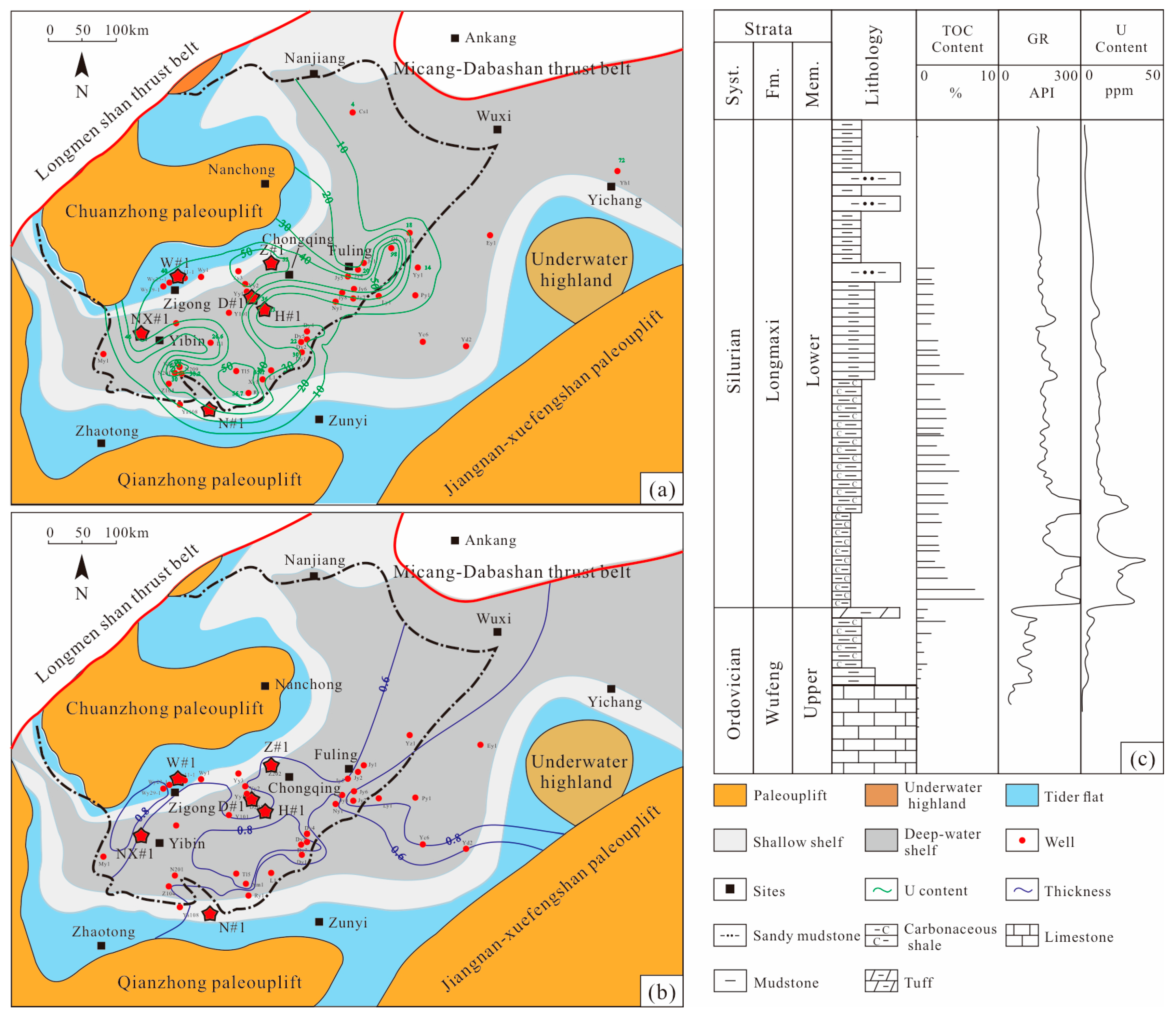

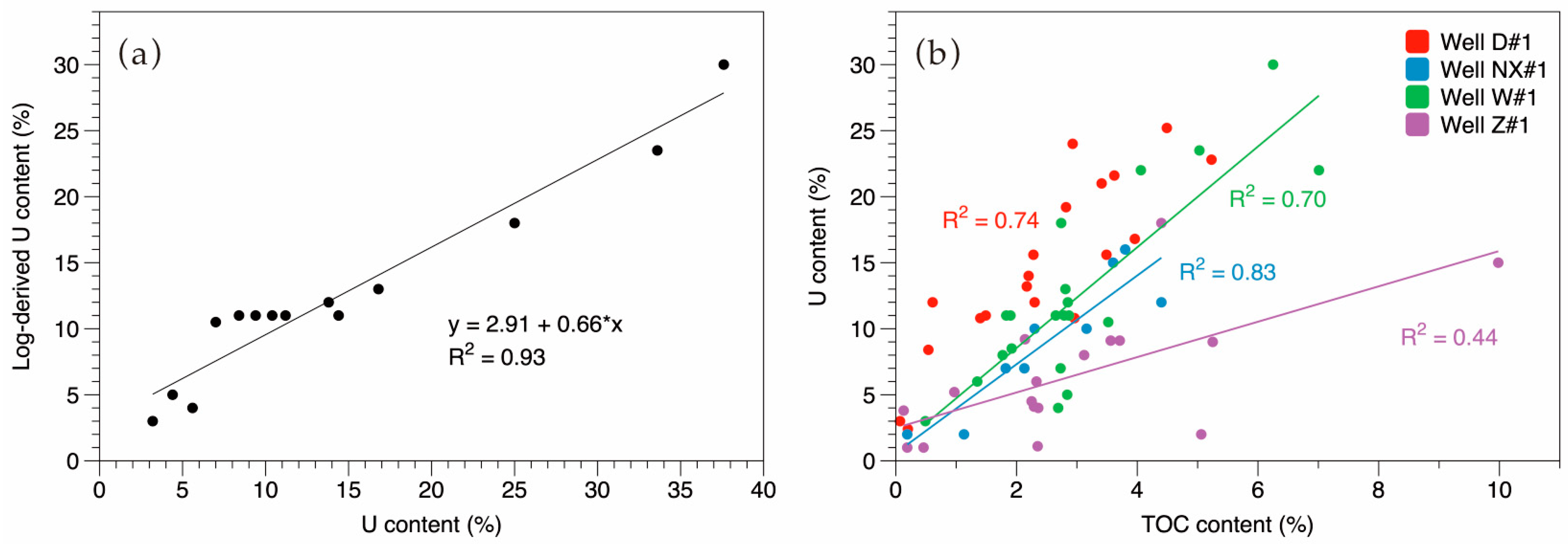

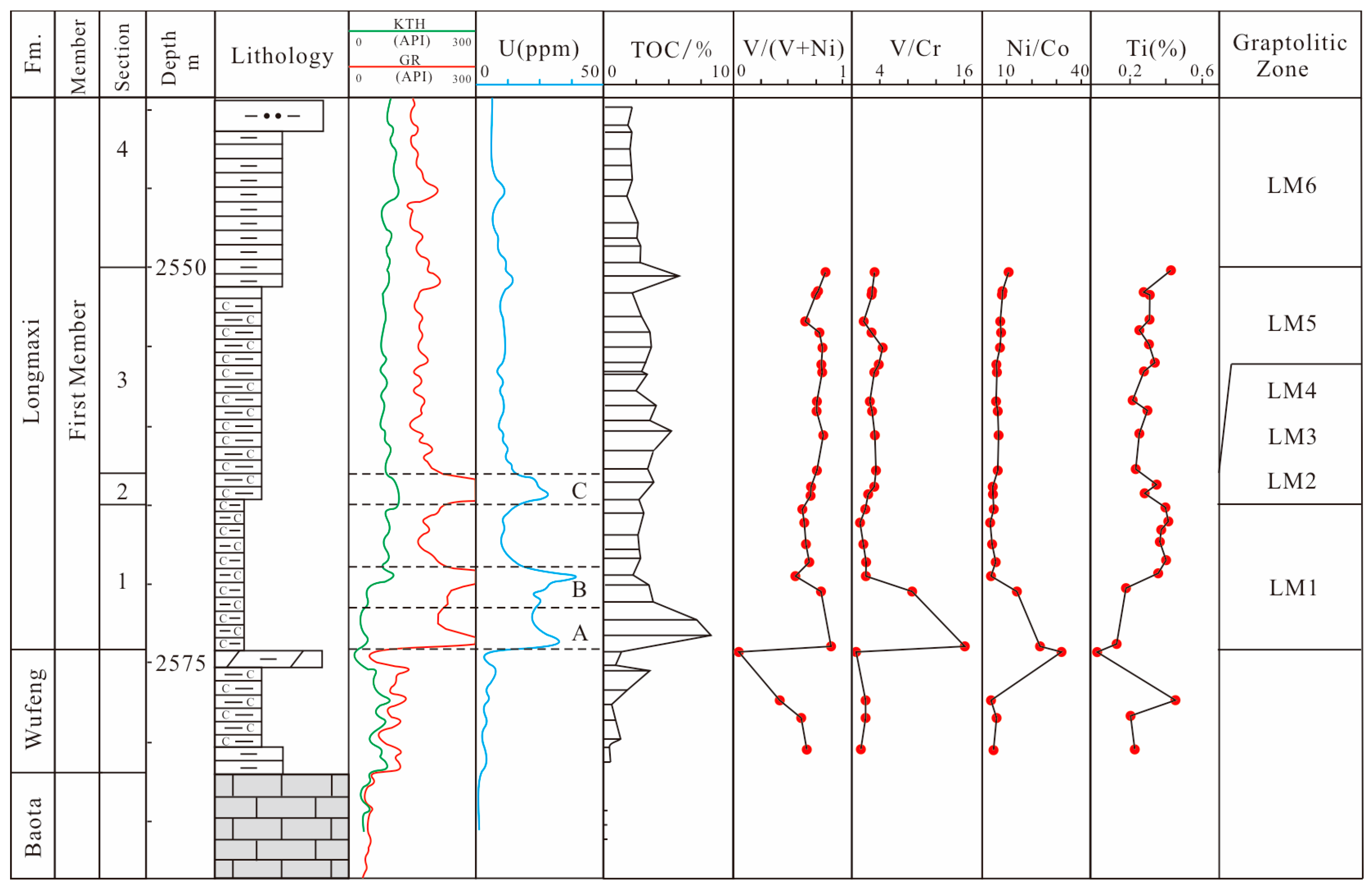


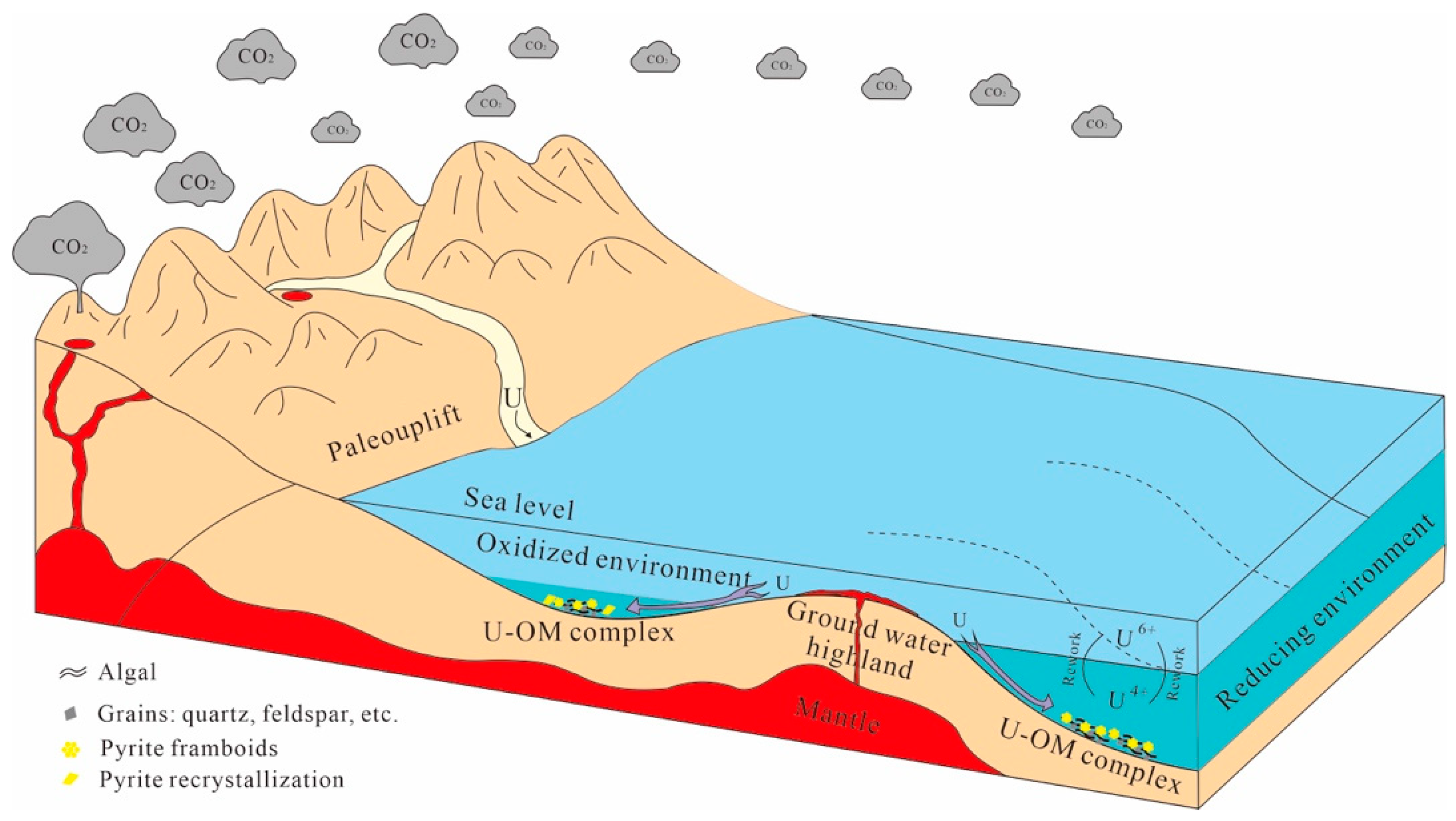



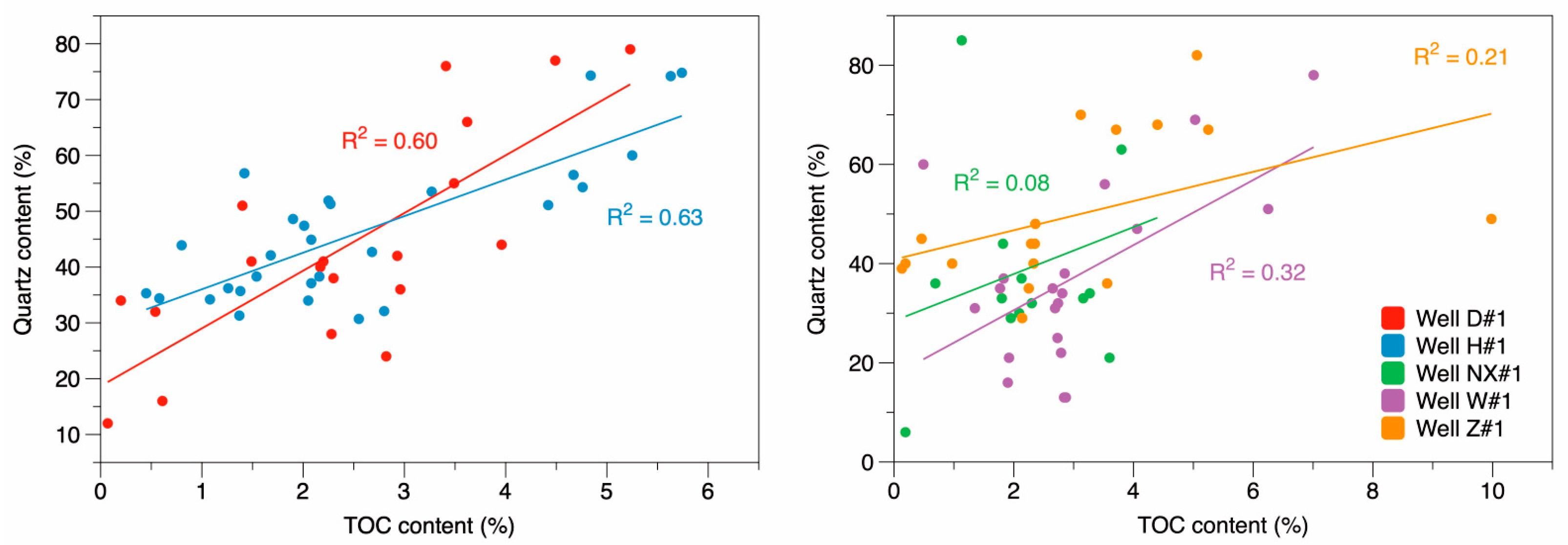

| Well | Sample | Depth m | TOC Content % | ERo % | U Content ppm | Organic Matter Types % | ||||
|---|---|---|---|---|---|---|---|---|---|---|
| Pyrobitumen | Algal Fragments | Graptolite | Micrinite | Bacteria-Like Aggregates | ||||||
| NX#1 | NX-1 | 3933.75 | 3.16 | 3.22 | 10.0 | 65 | 30 | 5 | 0 | 0 |
| NX-2 | 3934.17 | 4.40 | 3.29 | 12.0 | 80 | 15 | 2 | 3 | 0 | |
| NX-3 | 3944.40 | 1.82 | 3.48 | 7.0 | 45 | 25 | 10 | 0 | 20 | |
| W#1 | W-1 | 2549.50 | 2.24 | 2.16 | 11.0 | 40 | 40 | 0 | 5 | 2 |
| W-2 | 2575.00 | 3.35 | 2.22 | 4.0 | 75 | 10 | 10 | 5 | 0 | |
| Z#1 | Z-1 | 3877.09 | 2.25 | 2.25 | 4.5 | 70 | 25 | 0 | 5 | 0 |
| Z-2 | 3887.76 | 2.36 | 2.43 | 4.0 | 85 | 10 | 0 | 2 | 3 | |
| Z-3 | 3891.72 | 4.40 | 2.51 | 18.0 | 65 | 25 | 0 | 5 | 5 | |
| Z-4 | 3897.40 | 3.71 | 2.39 | 9.1 | 65 | 20 | 0 | 5 | 15 | |
| D#1 | D-1 | 3697.86 | 2.93 | 2.87 | 24.0 | 82 | 5 | 5 | 8 | 0 |
| H#1 | H-1 | 4114.00 | 3.27 | 3.07 | 4.0 | 75 | 5 | 5 | 10 | 5 |
| H-2 | 4127.60 | 2.05 | 3.16 | 7.2 | 60 | 35 | 5 | 0 | 0 | |
| Well | Sample | Depth m | Quartz % | Feldspar % | Calcite % | Dolomite % | Pyrite % | Clays % |
|---|---|---|---|---|---|---|---|---|
| NX#1 | NX-1 | 3933.75 | 33 | 1 | 60 | 3 | 1 | 2 |
| NX-2 | 3934.17 | 68 | 3 | 6 | 15 | 3 | 5 | |
| NX-3 | 3944.40 | 44 | 2 | 34 | 10 | 2 | 8 | |
| W#1 | W-1 | 2549.50 | 35 | 5 | 22 | 9 | 1 | 28 |
| W-2 | 2575.00 | 31 | 0 | 48 | 17 | 2 | 2 | |
| Z#1 | Z-1 | 3877.09 | 35 | 9 | 3 | 14 | 2 | 37 |
| Z-2 | 3887.76 | 48 | 12 | 9 | 4 | 2 | 25 | |
| Z-3 | 3891.72 | 68 | 4 | 2 | 3 | 5 | 18 | |
| Z-4 | 3897.40 | 67 | 5 | 0 | 3 | 6 | 19 | |
| D#1 | D-1 | 3697.86 | 42 | 42 | 15 | 23 | 5 | 12 |
| H#1 | H-1 | 4114.00 | 53 | 8 | 5 | 2 | 4 | 28 |
| H-2 | 4127.60 | 34 | 6 | 23 | 4 | 2 | 31 |
Disclaimer/Publisher’s Note: The statements, opinions and data contained in all publications are solely those of the individual author(s) and contributor(s) and not of MDPI and/or the editor(s). MDPI and/or the editor(s) disclaim responsibility for any injury to people or property resulting from any ideas, methods, instructions or products referred to in the content. |
© 2025 by the authors. Licensee MDPI, Basel, Switzerland. This article is an open access article distributed under the terms and conditions of the Creative Commons Attribution (CC BY) license (https://creativecommons.org/licenses/by/4.0/).
Share and Cite
Xie, G.; Jiao, K.; Liu, S.; Ye, Y.; Wang, J.; Deng, B.; Wu, J.; Feng, X. The Enrichment of Uranium in Marine Organic-Rich Overmature Shales: Association with Algal Fragments and Implications for High-Productivity Interval. Minerals 2025, 15, 1238. https://doi.org/10.3390/min15121238
Xie G, Jiao K, Liu S, Ye Y, Wang J, Deng B, Wu J, Feng X. The Enrichment of Uranium in Marine Organic-Rich Overmature Shales: Association with Algal Fragments and Implications for High-Productivity Interval. Minerals. 2025; 15(12):1238. https://doi.org/10.3390/min15121238
Chicago/Turabian StyleXie, Guoliang, Kun Jiao, Shugen Liu, Yuehao Ye, Jiayu Wang, Bin Deng, Juan Wu, and Xiaokai Feng. 2025. "The Enrichment of Uranium in Marine Organic-Rich Overmature Shales: Association with Algal Fragments and Implications for High-Productivity Interval" Minerals 15, no. 12: 1238. https://doi.org/10.3390/min15121238
APA StyleXie, G., Jiao, K., Liu, S., Ye, Y., Wang, J., Deng, B., Wu, J., & Feng, X. (2025). The Enrichment of Uranium in Marine Organic-Rich Overmature Shales: Association with Algal Fragments and Implications for High-Productivity Interval. Minerals, 15(12), 1238. https://doi.org/10.3390/min15121238






